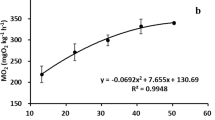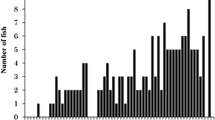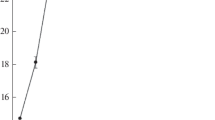Synopsis
Upper loss of equilibrium and death temperatures were determined by the critical thermal maximum (CTM) method for juvenile coho salmon (Oncorhynchus kisutch) acclimated to 5 and 15° C, and for pumpkinseed sunfish (Lepomis gibbosus) acclimated to 10 and 20° C. Temperature increase rates were 1, 6, 18, 30 and 60° C h−1. Analysis of variance showed significant (P < 0.5) differences due to acclimation level, temperature increase rate, and an interaction between these variables. CTM values for coho, a stenothermal fish, were lower than those for pumpkinseed, an eurythermal fish. Generally, higher acclimations and more rapid rates of temperature increase produced higher CTM values. Upward acclimation during testing was detected only for 10° C acclimated pumpkinseed at a 1° C h−1 increase rate
Assessments were made of CTM procedural relationships from test data and the literature. A 1° C min−1 (60° C h−1) temperature increase rate is so rapid that internal body temperatures of fish will usually lag behind media temperatures. A standard increase rate of 18° C h−1 (0.3° C min−1 is recommended for routine CTM determinations with fish. Other recommendations are: 1) Test fish should be small, and relatively uniform in size and condition; 2) final loss of ability to return upright should be the loss of equilibrium criterion; 3) death also should be included as a criterion in CTM determinations, with the term ‘lethal thermal maximum’ applied for death temperature; and 4) linearity should be maintained in time-temperature distributions of the heating rate. All procedures are also applicable to determinations of the critical thermal minimum. An amended description of the CTM is given that expands its scope.
Similar content being viewed by others
References cited
Barner, A. & J. A. Van Arman. 1973. Thermal effects on eggs, larvae and juveniles of bluegill sunfish. Environmental Protection Agency, Ecological Research Series, EPA-R3-73-041, Sup. of Doc., Washington, DC. 111 pp.
Brett, J. R. 1944. Some lethal temperature relations of Algonquin Park fishes. Univ. Toronto Studies, Biol. Ser. 52, Ontario Fish Res. Lab. Publ. 63: 1–49.
Brett, J. R. 1952. Temperature tolerance in young Pacific salmon, genus Oncorhynchus. J. Fish. Res. Board Can. 9: 265–323.
Cheetham, J. L., C. T. Garten, Jr., C. L. King & M. H. Smith. 1976. Temperature tolerance and preference of immature channel catfish (Ictalurus punctatus). Copeia 1976: 609–612.
Cocking, A. W. 1959. The effects of high temperatures on roach (Rutilus rutilus). II. The effects of temperature increasing at a known constant rate. J. Exp. Biol. 36: 217–226.
Committee on Water Quality Criteria. 1972. Water Quality Criteria 1972. A Report of the Committee on Water Quality Criteria, Appendix Table II-C. Environmental Studies Board, National Academy of Sciences. Supt. of Documents, Washington, D.C.
Copeland, B. J., R. W. Laney & E. C. Pendleton. 1974. Heat influences in estuarine ecosystem. pp. 423–437. In: J. W. Gibbons and R. R. Shartz (ed.) Thermal Ecology, CONF-730505, Nat. Tech. Inf. Serv., Springfield, VA.
Coutant, C. C. 1970. Biological aspects of thermal pollution. I. Entrainment and discharge canal effects. CRC Crit. Rev. Environ. Contr. 1: 341–381.
Cowles, R. B. & C. M. Bogert. 1944. A preliminary study of the thermal requirements of desert reptiles. Bull. Am. Mus. Nat. Hist. 83: 265–296.
Cox, D. K. 1974. Effects of three heating rates on the critical thermal maximum of bluegill. pp. 158–163. In: J. W. Gibbons and R. R. Sharitz (ed.) Thermal Ecology. CONF-730505, Nat. Tech. Inf. Serv., Springfield, VA.
Dean, J. M. 1976. Temperature of tissues in freshwater fishes. Trans. Am. Fish. Soc. 105: 709–711.
Dean, J. M. 1973. The response of fish to a midified thermal environment, pp. 33–63. In: W. Chavin (ed.) Responses of Fish to Environmental Changes, C. C. Thomas, Springfield, IL.
Fry, F. E. J. 1947. Effects of the environment on animal activity. Univ. Toronto Studies, Biol. Ser. 55, Ontario Fish. Res. Lab. Publ. 68: 1–62.
Fry, F. E. J. 1967. Responses of vertebrate poikilotherms to temperature, pp. 375–409. In: A. H. Rose (ed.) Thermobiology, Academic Press, NY.
Fry, F. E. J. 1975. Thermal physiological effects in aquatic ecosystems, pp. 101–115. In: Report of a Workshop on the Impact of Thermal Power Plant Cooling Systems on Aquatic Environments, Vol 11. Spec. Rept. 38, Electric Power Research Institute, Palo Alto, CA.
Fry, F. E. J., J. S. Hart & N. F. Walker. 1946. Lethal temperature relations for a sample of young speckled trout, Salvelinus fontinalis. Univ. Toronto Studies, Biol. Ser. 54, Ontario Fish. Res. Lab. Publ. 66: 9–35.
Hart, J. S. 1952. Geographic variations of some physiological and morphological characters in certain freshwater fish. Univ. Toronto Studies, Biol. Ser. 60, Ontario Fish. Res. Lab. Publ. 72: 1–79.
Hassen, K. C. & J. R. Spotila. 1976. The effects of acclimation on the temperature tolerance of young muskellunge fry. pp. 136–140. In: G. W. Esch & R. W. McFarlane (ed.) Thermal Ecology II, CONF-750425, Nat. Tech. Inf. Service, Springfield, VA.
Heath, W. G. 1967. Ecological significance of temperature tolerance in Gulf of California shore fishes. J. Arizona Acad. Sci. 4: 172–178.
Holland, W. E., M. H. Smith, J. W. Gibbons & D. H. Brown. 1974. Thermal tolerances of fish from a reservoir receiving heated effluent from a nuclear reactor. Physiol. Zool. 47: 110–118.
Hoss, D. E., L. C. Coston & W. F. Hettler, Jr. 1972. Effects of increased temperature on postlarval and juvenile estuarine fish. pp. 635–642. Proc. 25th Ann. Conf. Southeastern Game and Fish Commissioners.
Hutchinson, V. H. 1961. Critical thermal maxima in salamanders. Physiol. Zool. 34: 92–125.
Hutchinson, V. H. 1976. Factors influencing thermal tolerances of individual organisms pp. 10–26. In: G. W. Esch & R. W. McFarlane (ed.) Thermal Ecology II, CONF-750425, Nat. Tech. Inf. Serv., Springfield, VA.
Hutchinson, V. H., A. Vinegar & R. J. Kosh. 1966. Critical thermal maxima in turtles. Herpetologia 22: 32–41.
Lowe, C. H. & W. G. Heath. 1969. Behavior and physiological responses to temperature in the desert pupfish (Cyprinodon macularius). Physiol. Zool. 42: 53–59.
Lowe, C. H., Jr. & V. J. Vance. 1955. Acclimation of the critical thermal maximum of the reptile Urosaurus ornatus. Science 122: 73–74.
McFarlane, R. W., B. C. Moore & S. E. Williams. 1976. Thermal tolerance of stream cyprinid minnows. pp. 141–144. In: G. W. Esch & R. W. McFarlane (ed.) Thermal Ecology II. CONF-750425, Nat. Tech. Inf. Serv., Springfield, VA.
Otto, R. G. 1973. Temperature tolerance of the mosquitofish, Gambusia affinis (Baird & Girard). J. Fish. Biol. 5: 575–585.
Otto, R. G. & S. D. Gerking. 1973. Heat tolerance of the Death Valley pupfish (Genus Cyprinodon). Physiol. Zool. 46: 43–49.
Peterson, S. E. & R. M. Schutsky 1976 Some relationships of upper thermal tolerances to preference and avoidance responses of the bluegill. pp. 148–153. In: G. W. Esch & R. W. McFarlane (ed.) Thermal Ecology II, CONF-750425, Nat. Tech. Inf. Serv., Springfield, VA.
Seibel, R. V. 1970. Variables affecting the critical thermal maximum of the leopard frog, Rana pipiens Schreiber. Herpetologia 26: 208–215.
Smith, M. H. & S. L. Scott. 1975. Thermal tolerance and biochemical polymorphism of immature largemouth bass Micropterus salmoides Lacepede. Bull. Georgia Acad. Sci. 34: 180–184.
Spigarelli S. A., G. P. Romberg, W. Prepejchal & M. M. Thomas, 1974 Body temperature characteristics of fish at a thermal discharge on Lake Michigan. pp. 119–132. In: J. W. Gibbons & R. R. Sharitz (ed.) Thermal Ecology, CONF-730505, Nat. Tech. Inf. Serv., Springfield, VA.
Stevens, E. D. & F. E. J. Fry. 1974. Heat transfer and body temperature in non-thermoregulatory teleosts. Can. J. Zool. 52: 1137–1143.
Stevens, E. D. & F. E. J. Fry. 1970. The rate of thermal exchange in a teleost, Tilapia mossambica. Can. J. Zool. 48: 221–226.
Sylvester, J. R. 1975. Critical thermal maxima of three species of Hawaiian estuarine fish: a comparative study. J. Fish. Biol. 7: 257–262.
Author information
Authors and Affiliations
Rights and permissions
About this article
Cite this article
Becker, C.D., Genoway, R.G. Evaluation of the critical thermal maximum for determining thermal tolerance of freshwater fish. Environ Biol Fish 4, 245–256 (1979). https://doi.org/10.1007/BF00005481
Received:
Accepted:
Issue Date:
DOI: https://doi.org/10.1007/BF00005481




